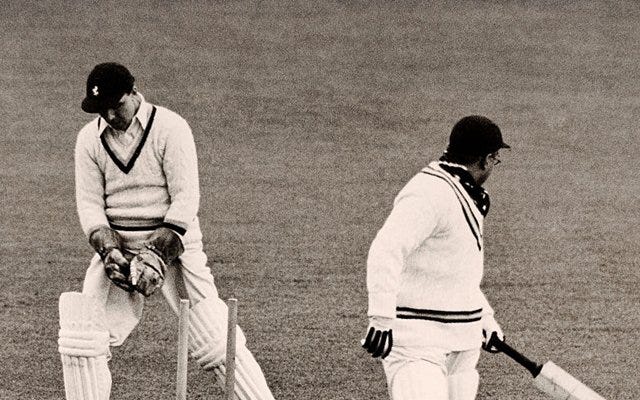Illustration 1: To the right is a forgotten , but infamous early captain of the Indian Test Cricket team -Maharajkumar of Vizianagaram. Known to have regularly humiliated Lala Amarnath and CK Nayudu and to have paid English cricketers to bowl easy to him
This is the fourth part of my reading reviews for 2024 (Read the third part here). In this part, I go back to two works of fiction I read last year. The first is actually a collection of novels - three later works by a much admired Science Fiction writer, which on a second reading appeared a trifle hollow/discordant. (I guess that is the difference between reading the same novel when you are 26 and then when you are 35). The second is the last part of a tetralogy. Initially meant to be a meditation on being an American, it is a universal tale of cruelty borne out of privilege, that to its perpetrator remains hidden behind innocence and lack of self awareness.
7,8,9. Later works in the Foundation and Robot Series: Isaac Asimov
Illustration 2: I consider Asimov’s later works much like the Easter Island Statues. Even unfinished, the mastery of their craftsmen fills you with awe. But it also makes you wonder, what if they were fully chiseled out?
Last year, I also re-read, for the third time - three latter works of Isaac Asimov. Foundation and Earth is a sequel to the Foundation Series. Prelude to the Foundation is a prequel. And Robots and the Empire is a bridge that joins the two large series - Robots and the Foundation - which form one of the greatest collections of science fiction works this side of the universe. I was first exposed to the works of Asimov when I was 8, when my brother used to get his novels on a 2-week borrowing limit from the school library.
Since then, I have read them in trains while on my way to college, at home during holidays and lately, as a vengeful desire to save those memories after having seen their gross bastardization by an Apple TV series of the same name. However, between each of these reads, I have sampled other authors, and have hopefully grown in my literary tastes. Hence, each read feels slightly different. Lately, the later works of Asimov, after having been through Douglas Adams, Robert Heinlein, Liu Cixin -among the notables, seem to have an aura that never matches those of his original Foundation and Robot novels which he wrote in his 30s and 40s.
However, even in his later works, Asimov is a master of big ideas in sci-fi. The victory of intuition over rigor, the importance of obsolescence in social systems, the mythologization of our present by societies of the future - Asimov owns these concepts even before today’s ethicists and sociologists can imagine them.
In Foundation and Earth we see how culturally conservative and economically stagnant societies try to claim descent from an authentic original heritage (the Earth) and pretend to invent a golden age in the past to keep themselves from falling apart. In Prelude to the Foundation, he explores how large administrative systems - such as the Galactic Empire - end up eerily resembling the Ottoman Empire - with the ruler slowly delegating responsibilities to a class of bureaucrats and creating a top-heavy elite class, receding from public life and eventually ruling over a complex sandpile of a system that can break down after a single shock. In Robots and the Empire, he brings out the cons of a future where humans are so long lived and young that they lose the desire to accomplish anything that death or old age pushes them to.
However, sitting beside these big ideas are hollow, one-dimensional characters. Asimov was never great at creating memorable characters. His heroes and heroines are intensely cerebral. You solve murder mysteries with them. You marvel at their political and military stratagems. But you never get to know who they are. Romance feels like an antiseptic ingredient thrown in. You never feel the rage/revenge or motives behind violence. Things are explained. Not felt.
These things don’t jar you so much in the early Foundation and Robot novels, when he is just laying out his world before you. You are too engrossed in the plot to notice the characters. But someone reading the later novels knows what Terminus is. What happened to the Foundation. Who the Robots are. At each re-read, the one-dimensionality of characters as plot elements becomes starker. Especially if you are coming there after reading about Starks in George RR Martin’s universe.
In real life, Isaac Asimov was the polar opposite of moody Martin. Someone so prolific that he has written a book under each category of Dewey library classification. The later Asimov was also a living legend. He got advances worth millions from publishers to keep expanding the Foundation and the Robot universes.
The initial Foundation and Robot novels were written in a serialized format in magazines. Ergo, the structure of a magazine imposed a tight limit on words and expressions. That discipline seems to be lacking in his later novels. They could have been shorter. Or if they were longer, they could have let their characters wander around a bit from their main quest. To let the readers understand their motivations better.
However, all of these complaints are simply nitpicks. Maybe my attempt to pick flaws in the technique of someone who is just being compared to his best self. Even at 80 percent of his capacity, Asimov is light years ahead of his peers. Also, even greats like Frank Herbert messed up the later novels in the Dune saga.
It is just so tough to live up to the readers’ tastes and expectations, doubly so if you have played such an important role in their evolution. The achievement of the later novels is their ability to provide a cogent, logical and coherent ending to a series of 15 novels, spanning thousands of years, with little retconning and with no loose ends left behind.
Throw in the fact that all the big ideas propounded in the first novels 50 years ago don’t contradict themselves in the later versions. Can anything else be a better modern epic?
Illustration 3: Something about Pankaj Tripathi in Gurgaon, reminded me of Updike’s Harry “Rabbit” Angstrom in the Rabbit Tetralogy
Rabbit at Rest is the final novel in John Updike’s Rabbit tetralogy - four novels, spanning 1960-90, about the life of a suburban, white American man. The one living at the top of the hierarchy in a nation at the pinnacle of its time in history. This is a novel that perhaps my father picked up in the early 90s, when he used to bring in a lot of paperbacks from thrift book stores. It was lying around, unclaimed and unread, until I laid my hands on it - 34 years since its publication.
Harry “Rabbit” Angstrom, reminds me, as an Indian, of the dozens of singularly average but remarkably lucky men born, in my time and age, in Gurgaon or Dubai. Men, whose bank balances and conditions in life, are owed not to themselves - but to the rising tide of economic prosperity that has lifted their regions and countries to heights history had never seen. They glide through their world, imbibing TV/Internet culture, embracing aggregation - especially of houses and cars, as an evidence that they belong to this abundance around them.
Harry Angstrom, 55 in this novel, lives in a similar America of the late 1980s. He has ridden on the thrift of his father-in-law and a subservient wife to own properties in the Midwest and Florida. He pretends to justify his lechery towards other women and later, a one-night-stand with his daughter-in-law, by telling himself that he is giving these distressed women some relief through sexual intercourse. All of this abundance and absence of moral consequences for his actions overwhelms his body so deeply, that often the only time he is at rest and reflection is when he has drugs pumped into his arteries for an angiogram.
And yet, despite all these despicable acts, Updike makes you feel for him. People who read this book tell me that it is a comic satire on America at its heights. I believe it is bigger.
It is the story of human struggle to find meaning when all the conflicts are won, all the material problems are solved, when all you want is at your fingertips - supersized. In that sense, “Rabbit” has existed in all countries, some time, when they were just at their historical apex.
It is not his fault. He has lived like an entitled child, confident that the country, society and his family will cater to his needs and protect him. He is pampered by his mother. He lives in the reflected glory of a country that defeated fascism. He became a star basketball player when in high school. He inherited a successful car dealership from his in-laws. Something behind this success must be intrinsic.
Rabbit is a man who, like an investment fund manager in bull markets, believes that all his convictions are winning strategies. Until age, and its excesses begin to catch up on him.
Rabbit at Rest is highly recommended. Both for its condemnation of a man’s privilege and his empathy towards his vulnerability.
It is a meditation on what happens when you go through a lifetime of privilege, holding on fiercely and yet secretly acknowledging that you are an impostor.
That your best is behind you.
Where you never encounter someone who shakes you by your shoulders and makes you take stock of the dysfunction you have wrought upon your loved ones.
And finally, what remains as a residue in your head when death comes.
Suddenly.
The next part of this essay will continue with works of fiction. Where I review a biography that is a masterclass in being concise. And what reading a book in Bhojpuri/Hindi could make one feel in Scotland. (Less a nostalgia about the past in my case, but a sense of loss on how we tore away a state, maddened by our obsession with each others’ surnames)



